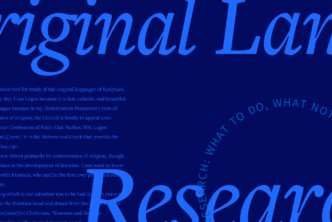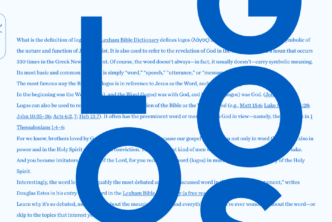The article—originally entitled A World without God (Bible Study Magazine, Nov–Dec 2011)— is written by Douglas Mangum. Douglas has an MA in Hebrew Bible from the University of Wisconsin-Madison and is a contributing editor at Logos.
A world without God
“The earth was without form (תהו, tohu) and void (בהו, bohu), and darkness was over the face of the deep. And the Spirit of God was hovering over the face of the waters” (Gen 1:2). The word pairing of the synonyms tohu and bohu doesn’t make this passage any clearer. What does it mean that the earth was formless and void? Did it already exist and God just shaped it? And did God create the matter and then shape it for a purpose?
But with a few interpretive steps, nearly any questions we have about an Old Testament pairing can be answered.
Identify the Original Words and Search for the Phrase
After finding the original Hebrew phrase behind the English “without form and void”—using the ESV English–Hebrew Reverse Interlinear—we can search for the phrase using Logos 4.In doing so, we learn that Isaiah and Jeremiah reworked this creation imagery to assert God’s authority and warn of Israel’s impending judgment. Jeremiah warned of Judah’s coming destruction by describing a future land where God’s creative energy had been reversed in punishment to unmake all things: “I looked on the earth, and behold, it was without form (tohu) and void (bohu); and to the heavens, and they had no light” (Jer 4:23).The prophet Isaiah also used tohu and bohuto describe God’s judgment as an end to civilization and the return of the land to untamed wilderness (Isa 34:11). Both tohu and bohu can refer to an empty, lifeless wasteland. The use of these words together is so rare that we can surmise that Jeremiah and Isaiah probably had Genesis 1 in mind. The prophets made powerful connections to the image of Israel’s greatest fear—a return to primordial chaos. A world without God seemed like no world at all.
Examine Passages with Similar Themes
The Old Testament was written over hundreds of years, which means that later writers were sometimes subtly responding to other biblical passages. They often played off familiar themes to make an unexpected point. One of their favorite themes to tie in and repurpose was God’s role as creator and sustainer of life.We can find these connections by looking up key words, like tohu, in a lexicon. Using The Hebrew and Aramaic Lexicon of the Old Testament(HALOT), we find other passages that expound on creation. In Isaiah 45:18, the prophet stresses that God’s primary objective was to provide purpose and order: “For thus says the Lord, who created the heavens [He is God!], who formed the earth and made it [He established it; He did not create it empty [tohu], He formed it to be inhabited!]: ‘I am the Lord, and there is no other.’ ”Isaiah is responding directly to the idea that God created an empty wasteland first, arguing, “No, He didn’t create a formless world. That was just one minor step in the process. He intended an inhabited life-giving world.”Isaiah focuses on God and His uniqueness, not the pre-existent state of creation. God brought form, function and order to His creation. His blessing is symbolized by order; His judgment by chaos.
State What It Tells Us about God
When reading the Bible, we must ask: how is the ultimate author of our text, God, depicted? From the opening lines of Genesis 1, God is depicted as the one who gives life, order and purpose to all things. A thriving creation is under His blessing; the wastelands are outside of His care—awaiting His creative hand.
Adapted from an article in Bible Study Magazine, published by Logos. Each issue of Bible Study Magazine provides tools and methods for Bible study as well as insights from people like John Piper, Beth Moore, Mark Driscoll, Randy Alcorn, Priscilla Shirer, and more. Originally published in print: Copyright Bible Study Magazine (Nov–Dec 2011): pg. 44–45.




